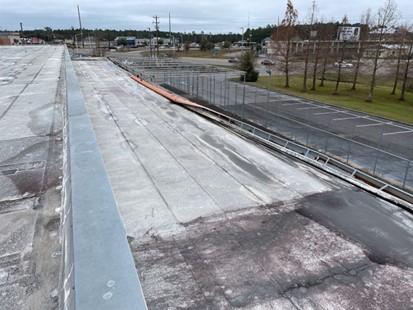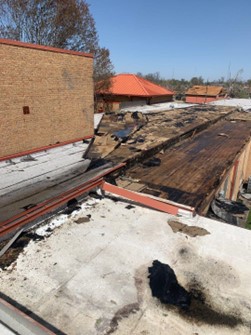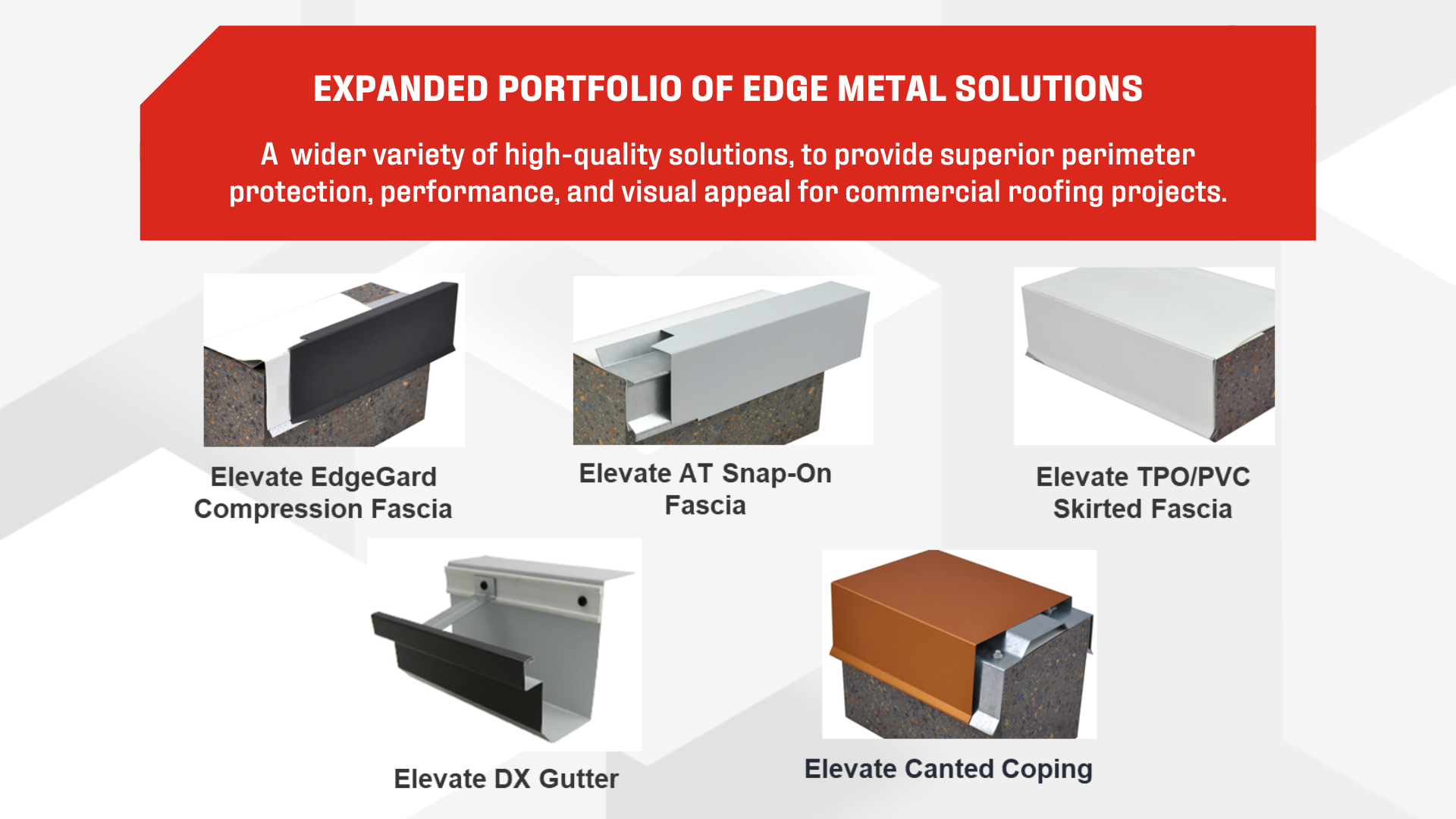When it comes to commercial roofing systems, edge metal plays a critical yet often underappreciated role. As the first line of defense against wind uplift, weathering, and structural vulnerabilities, edge metal ensures both the longevity and resilience of roof assemblies. Beyond its functional importance, edge metal also contributes to the visual appeal of a building, creating clean, defined rooflines that enhance architectural designs. The structural and aesthetic significance of edge metal, the critical role of ES-1 compliance, and the variety of solutions available for different performance and budget needs demonstrates why edge metal is indispensable for meeting diverse project needs.
The Importance and Benefits of Edge Metal
Edge metal ensures the resilience of commercial roofing systems by safeguarding against wind uplift and extreme weather conditions. Acting as a barrier, it helps prevent wind from lifting roof membranes and reduces the risk of detachment and subsequent structural damage. This function is especially critical in regions prone to high winds, where roof edges require additional reinforcement to withstand environmental stresses. Edge metal also protects against water infiltration, offering added resistance to leaks and ensuring the durability of the entire roofing assembly.
In addition to weather protection, edge metal reinforces the structural stability of roof assemblies, maintaining perimeter integrity across various building designs. Buildings with large roof spans or unique architectural needs require significant support to ensure stability and long-term performance. When applied to low-slope roofs, edge metal provides essential solutions for a variety of environments, including data centers, hospitals, and cold storage facilities. By balancing structural performance with aesthetic considerations, edge metal meets the demands of a wide range of building types. Edge metal also contributes to energy efficiency by minimizing thermal bridging at roof edges, helping to maintain airtightness and reduce energy loss.
Edge metal not only provides critical structural benefits but is vital in enhancing a building’s overall appearance. With clean, defined lines, edge metal complements architectural designs and elevates the visual impact of high-profile projects such as hotels and office buildings, where aesthetics are paramount. This ensures that edge metal supports both sustainability goals and long-term performance, making it an essential component for buildings that prioritize both form and function.
Code Requirements and ES-1 Compliance
ES-1, the industry standard for testing the wind resistance of edge metal assemblies, ensures edge metal can withstand specific wind loads and remain securely attached. Adopted by the International Building Code (IBC) in 2003, ES-1 compliance has become essential for modern commercial roofing projects. Meeting this standard ensures reliable performance, reduces liability for contractors, and ensures adherence to local building codes. For architects, specifiers and contractors, specifying ES-1 compliant edge metal provides confidence that systems are engineered for safety and durability under real-world conditions.

Despite its importance, misconceptions about ES-1 compliance persist, such as the belief that all ES-1-compliant products perform equally well. In reality, not all ES-1-compliant products perform the same, as factors such as profile size of the edge metal, material type, fastener locations, and system engagement methods significantly influence performance. Moreover, compliance alone does not ensure success if products are installed improperly. Certified systems must be paired with proper installation practices to effectively meet project-specific requirements. Without attention to these details, even compliant systems can fail to deliver the intended safety and durability. Choosing an experienced, licensed roofing contractor ensures the system is installed correctly and performs to its full potential.
In today’s evolving roofing industry, ES-1 compliance has become more critical than ever. Updated regularly to reflect new wind zone data and evaluation methods, ES-1 ensures that edge metal systems can withstand modern environmental challenges. Compliance now depends not only on the products but also on installation practices, emphasizing the need for properly trained contractors to meet code requirements. As the primary testing standard for edge metal assemblies, ES-1 continues to play a pivotal role in ensuring the long-term performance and safety of roofing systems.
Tiered Edge Metal Solutions
Contractor-fabricated edge metal is a custom solution created using flat sheets and slit coils provided by system manufacturers. Licensed contractors can use these materials to fabricate edge metal designs geared towards specific project requirements, offering a cost-effective option for meeting ES-1 test standards. However, any contractor-fabricated system must be reviewed and approved by the roofing system manufacturer to ensure long-term performance and compliance with warranty guidelines. While this approach provides flexibility, the performance of contractor-fabricated solutions relies heavily on strict adherence to system manufacturer specifications during fabrication and installation. This makes them best suited for projects that prioritize customization but do not require the highest levels of pre-engineered consistency and durability found in prefabricated systems.
Fully prefabricated edge metal systems offer the highest levels of durability, reliability, and ES-1 compliance. By design, these solutions are engineered to withstand the wind pressures exerted on the building envelope, ensuring long-term performance and eligibility for extended warranties. Prefabricated systems are manufactured with high-quality materials that are shaped, bent, and pre-punched, with each product validated through third-party testing.
Selecting the right edge metal solution requires careful consideration of factors such as building type, environmental conditions (e.g., wind zones and saltwater exposure) and budget constraints. For projects requiring maximum durability, such as hospitals that support critical healthcare infrastructure or retail facilities with large roof spans exposed to wind uplift, prefabricated edge metal systems are often the best choice. Additionally, validating material, gauge, size, fastener type, and fastening pattern into different substrates (wood, steel, masonry, etc.) through third-party testing is critical to ensuring the chosen system meets or exceeds the building’s design pressure requirements.
Practical Applications for Various Building Types
Edge metal is a universal requirement for commercial roofs, ensuring securement along the perimeter, and serving as the first line of defense against severe weather. Its role varies across building types:
- Data Centers: Wind uplift protection is critical for ensuring uninterrupted operations in these high-stakes facilities, where any disruption can result in significant costs.
- Hotels: Edge metal balances durability with aesthetics, providing structural integrity while maintaining a polished appearance for high-profile locations.
- Retail and Mixed-Use Facilities: It protects against weathering, ensures compliance with local building codes, and delivers consistent performance.
- Industrial and Warehousing: Supports large roof spans and withstands harsh conditions, offering durability and reliability in demanding environments.
Importance of Proper Specification and Installation

Specifying the appropriate edge metal begins with a thorough assessment of environmental factors, including wind loads, building height, geographic location, and risk ratings. These variables are critical in calculating wind design pressures for each project, ensuring the selected edge metal solution meets or exceeds the necessary performance standards. For instance, a design pressure of 100 psf (the calculated force exerted by wind on a roof system, measured in pounds per square foot) requires an edge metal system tested and validated to withstand 100 psf or more, with written documentation provided by the system manufacturer or independent third-party approval by a testing organization, such as UL Solutions, and Intertek Testing Services NA Inc. This validation process ensures conformance with the ES1 test standards and guarantees that the specified solution can deliver the required durability and safety under real-world conditions.
Proper installation is just as vital as specification, as even the highest-quality materials can fail if installed incorrectly. Pre-engineered solutions must not only meet wind design criteria but also be manufactured and installed as tested. Modifications, such as changing the material gauge, fastener types or fastening patterns, can significantly affect performance and aesthetics if not properly validated. For example, substituting a hex-head fastener for a low-profile tested fastener can disrupt the installation, leading to compromised performance and visual inconsistencies. Ensuring adherence to tested solutions and manufacturer guidelines minimizes liability for architects and contractors while guaranteeing the project meets safety and performance standards.
Elevate AdvantEdge Metal Edge Solutions
At Elevate, we understand that a high-performance roofing system requires reliable edge protection to safeguard your roof system from wind and water infiltration. That’s why we offer a comprehensive portfolio of pre-manufactured metal edge products. Whether your project involves EPDM, TPO, PVC, or Modified Bitumen systems, our AdvantEdge metal edge solutions provide the durability and performance you need while enhancing the overall aesthetics of the building.
Our metal edge offering delivers robust protection, ease of installation, and long-lasting performance, making them an essential component of any commercial roofing system.
- Comprehensive Protection: Our metal edge systems serve as the first line of defense against wind uplift and water infiltration, preserving the integrity of your roof.
- Versatile Options: We offer a variety of profiles, including fascia, coping, drip edge, and gravel stop, available in both standard and custom configurations to meet your project’s unique requirements.
- Time & Cost Savings: As pre-manufactured solutions, our products streamline installation, reducing labor time and minimizing on-site fabrication needs.
- Code-Compliant Performance: All Elevate AdvantEdge metal systems are tested to ensure compliance with code performance standards and to meet stringent industry standards.
- Peace-of-mind with a comprehensive warranty offering: All Elevate metal edge products are eligible for the Elevate Red Shield™ Limited Warranty* for up to 30 years, and meet stringent industry standards for superior reliability.
Recent News: AdvantEdge Expansion
Our recent AdvantEdge metal edge expansion takes durability and longevity to the next level. Engineered for easy and efficient installation, these pre-manufactured solutions come complete with all necessary fastening equipment, ensuring a hassle-free process for contractors. Nearly all of our AdvantEdge products comply with ANSI/SPRI/FM 4435/ES-1 test standards, providing industry-leading performance and reliability for a variety of applications and code requirements. Additionally, our curated range of colors aligns with national trends and regional aesthetics, allowing your projects to seamlessly blend with their architectural surroundings while making a lasting impression.

Read the Announcement on our Expanded AdvantEdge Metal Edge Solutions
Conclusion
Elevate AdvantEdge metal edge products serve as the building’s first line of defense, providing critical protection against wind uplift, weather-related damage and structural vulnerabilities. Its importance extends beyond functionality, offering ES-1 tested, pre-engineered solutions that help enhance energy efficiency and contribute to a building’s visual appeal.
With Elevate’s ES-1 tested systems and pre-engineered solutions, architects, contractors, and specifiers alike can choose tailored options to meet diverse project needs, from data centers to retail facilities. By integrating Elevate AdvantEdge metal edge into roof designs, projects can benefit from its superior durability, streamlined installation, and long-term performance. Prioritizing edge metal in roof design helps safeguard investments, enhances performance and helps ensure compliance with modern building standards—ultimately redefining the possibilities of commercial roofing.
**When installed by a licensed Elevate Red Shield applicator.